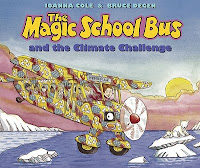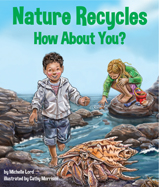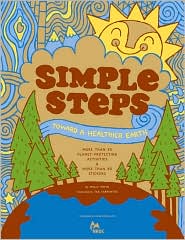Here is my first review for TTLG's Save the Environment Month. Enjoy!
Joanna Cole
Illustrated by Bruce Degen
Picture Book
Ages 7 to 9
Scholastic, 2010, 978-0-590-10826-3
Ms. Frizzle and her class are going to put on a play about the Earth and “all the changes” that are taking place all over the planet because of global warming. One morning Ms. Frizzle brings in a book for the children to use to help them create pictures for the scenery for their play. Unfortunately, the book is rather out of date and Ms. Frizzle decides that the children need to go on a field trip so that they can better understand what is happening to the Earth and why.

The adventure begins in the Arctic Sea, and when the children compare the picture in Ms. Frizzle’s book with what they are seeing outside of the school bus window, they quickly realize that there is a lot less ice outside then there was some years ago. Apparently, an area of ice the size of “
Texas and
California combined” has melted in the
Arctic.
The school bus (actually, it is a plane at this point) flies all over the planet and the children see how global warming is causing problems all over the planet. They see crops being destroyed by freakish weather, rising sea levels, melting permafrost, drought, blizzards, and much more. The question is what is causing all these changes? What is global warming and why is it happening?
In this excellent Magic School Bus title, children are given a very clear and comprehensive picture of what global warming is, why it is happening, and what all of us can do to protect our home planet from global warming in the future. As with all the Magic School Bus titles this book is packed with information that is presented in a way that is both interesting and visually engaging.
You can find out more about the book on
the official book page Find out more information on Ms. Frizzle’s April 20th Webcast:
Find out more information on Ms. Frizzle’s April 20th Webcast:Climb on board with author Joanna Cole and illustrator Bruce Degen on Tuesday, April 20th at 1pm ET / 10am PT as they join Ms. Frizzle to celebrate Earth Day and their new book The Magic School Bus and the Climate Challenge at the Liberty Science Center in
.jpeg?picon=1639)
By:
Shadra Strickland,
on 5/29/2009
Blog:
Living the Dream...
(
Login to Add to MyJacketFlap)
JacketFlap tags:
school visits,
kids' books,
eric carle museum,
environmental books,
Fieldwork,
Teacher's Rock!,
camille kirby,
the plant helpers,
Books,
Illustration,
Uncategorized,
Add a tag
This year I worked with Learning Leaders to visit NY classrooms and share my work with kids. I did 8 visits between two classes over the course of 4 consecutive months. For the activity portion of my visit we made single sheet books where the kids had to tell a story with pictures only! It was a challenge in the beginning, but the kids got into the mode of thinking very quickly and made some really impressive books. Most kept their books for themselves, but a couple of the students gave theirs to me!
This is a super confidence building activity for children who struggle with writing. It also helps sharpen their ordering skills.
Here is one of the finished products. Enjoy! (click on the pages to enlarge)



The Plant Helpers by Camille Kirby, Age 9
Synopsis: A bad man comes along, chops down a tree and takes it away. The children go to the community garden to buy seeds. They plant the seeds and one week later flowers, trees, and pumpkins grow, everyone is happy.
Sarah Stewart and David Small’s The Gardener and Peter Brown’s The Curious Garden would be great additions to Camille’s library!

*Also of note*
The Eric Carle Museum of Picture Book Art has offered me a complimentary membership to the museum as a token of congratulations! How cool is that?!?! I can’t wait to go, who’s comin’ with me?

I first heard about the Alberta tar sands in Becky's Farm School blog. Becky actually writes primarily about homeschooling and I have found a ton of reading recommendations for my son at her site. But she is also from Alberta and feels very strongly about the tar sands. Here's an entry from last spring on the subject:
I’m writing about the duck deaths at the Syncrude tailings pit earlier this week not because I’ve dug out any news of my own, or have any noteworth comments, but because I’d like to help spread the news of this incident in particular and the tar sands in general beyond Alberta’s borders, especially to the U.S. The New York Times ran the story yesterday. And for the sake of my own province, I’d like to see some leadership that includes the generous use of courage, brains, and heart.
Yesterday I wrote about the sad and worrisome incident of several hundred migratory ducks killed when they landed Monday on one of Syncrude’s tailing pits in northern Alberta; the number of ducks hasn’t been confirmed because Syncrude isn’t allowing reporters near the site, and Alberta Environment hasn’t seen fit to release any photographs, video, or other reports from the site. In fact, Alberta’s government is now facing accusations of a cover-up for refusing to release photos of the dead ducks. In that post, I mentioned the conservative provincial government’s new $25 million PR campaign to convince the rest of the world in general, and the US in particular, that Alberta’s tar sands are clean and the province looks after the environment well.
Because of my small knowledge on the subject gathered from Becky's posts and following her links, I recognized just how important Andrew Nikiforuk's new book, Tar Sands: Dirty Oil and the Future of a Continent, must be when I saw it in the Greystone catalog. My reaction to this subject has been like the first time I read about mountaintop mining and began to realize how much of the world I had been missing. (For a recent article on that topic from West Virginia see Smithsonian's "Mining the Mountains".) To bring some attention to the tar sans and the book, Greystone is releasing the entire thing - all 208 pages of it - for free on pdf today. Here's a bit of the book's description:
The United States imports the majority of its oil, not from Saudi Arabia or Venezuela, but from its neighbour to the north, Canada. Canada has one third of the world’s oil source; it comes from the bitumen in the oil sands of Alberta. Advancements in technology and frenzied development have created the world’s largest energy project in Fort McMurray where, rather than shooting up like a fountain in the deserts of Saudi Arabia, the sticky bitumen is extracted from the earth. Providing almost 20 percent of America’s fuel, much of this dirty oil is being processed in refineries in the Midwest. This out-of-control megaproject is polluting the air, poisoning the water, and destroying boreal forest at a rate almost too rapid to be imagined.

So here's the deal. I get emails from publishers all the time asking me to publicize some event they are doing for a certain book ranging from giveaways to parties to general brouhaha. Most of them I ignore because general PR is just not the sort of thing I do here. (Writing about Alaska, haunted houses and lately Edgar Allen Poe is what I do.) However, and in this case it is a very big however, this subject is something I feel very strongly about and any way I can let more people know about it is, I think, a very good use of my time (and blog space).
This kind of all out scorch the earth mentality mining just....it bothers me. Ever since I read Erik Reece's book Lost Mountain about the heavy price being paid in Kentucky for mountaintop removal coal mining I've been angry about how oblivious the rest of us are to that price.(See my Bookslut review.) We think our electric bills are low and that's all there is to it but bad things are happening because of how we mine the earth. I won't even make the environmental argument; just read this from that Smithsonian article I linked to above:
Scientists and community groups are concerned about the possible effects of coal-removal byproducts and waste. Ben Stout, the biologist, says he has found barium and arsenic in slurry from sites in southwestern West Virginia at concentrations that nearly qualify as hazardous waste. U.S. Forest Service biologist A. Dennis Lemly found deformed fish larvae in southern West Virginia's Mud River—some specimens with two eyes on one side of their head. He blames the deformities on high concentrations of selenium from the nearby Hobet 21 mountaintop project. "The Mud River ecosystem is on the brink of a major toxic event," he wrote in a report filed in a court case against the mining site, which remains active.
If that isn't disturbing enough, National Geographic has an article up this month on the tar sands themselves. Here's a bit of that:
"The thing that angers me," says David Schindler, "is that there's been no concerted effort to find out where the truth lies."
Schindler, an ecologist at the University of Alberta in Edmonton, was talking about whether people in Fort Chipewyan have already been killed by pollution from the oil sands. In 2006 John O'Connor, a family physician who flew in weekly to treat patients at the health clinic in Fort Chip, told a radio interviewer that he had in recent years seen five cases of cholangiocarcinoma—a cancer of the bile duct that normally strikes one in 100,000 people. Fort Chip has a population of around 1,000; statistically it was unlikely to have even one case. O'Connor hadn't managed to interest health authorities in the cancer cluster, but the radio interview drew wide attention to the story. "Suddenly it was everywhere," he says. "It just exploded."
There are so many things we have to worry about in the world today; we have to pick and choose our battles. If we don't pick and choose, quite frankly, I think we would all go a little bit mad. Mountaintop removal, the poor maintenance of slurry ponds and the mining of tar sands are all things that mystify and disturb me. I choose therefore to let you all know about them and how you can learn more about them, whenever I can. The free download for Tar Sands: Dirty Oil and the Future of a Continent is good for five days. Take Greystone up on this offer and then you too will know more of the dirty truth of the price we pay for energy. And then you will know more of what you want to say to your Congressmen & women and Senators when these issues come up.
[Post pics of the Alberta tar sands. Top pic from The Globe & Mail, bottom from Nat Geo. I don't believe the mining company either when they say they will be beautiful boreal forests again someday.]


By: Rebecca,
on 11/13/2007
Blog:
OUPblog
(
Login to Add to MyJacketFlap)
JacketFlap tags:
geographic,
provisioned,
veteran’s,
atlas,
ben,
oupblog,
week,
keen,
perch,
online—the,
council,
Education,
Current Events,
Geography,
A-Featured,
Ben's Place of the Week,
awareness,
Add a tag

With Election Day, Veteran’s Day, and Thanksgiving all squeezed into the first three weeks of the month, November may seem to be amply provisioned holiday-wise. As resident champion of place-related news here at Oxford, I feel obligated to mention another event that seems to have escaped the attention of calendar-makers nationwide for the last twenty years: Geography Awareness Week. (more…)
Share This
 Did you know that the first Earth Day was on April 20, 1970?
Did you know that the first Earth Day was on April 20, 1970? From sea urchins in the Atlantic Ocean to bandicoots on the Australian savanna, animals all over the world recycle. Explore how different animals in different habitats use recycled material to build homes, protect themselves and get food. This fascinating collection of animal facts will teach readers about the importance of recycling and inspire them to take part in protecting and conserving the environment by recycling in their own way.
From sea urchins in the Atlantic Ocean to bandicoots on the Australian savanna, animals all over the world recycle. Explore how different animals in different habitats use recycled material to build homes, protect themselves and get food. This fascinating collection of animal facts will teach readers about the importance of recycling and inspire them to take part in protecting and conserving the environment by recycling in their own way. Chicken Little may have thought the sky was falling but Peter Pika is sure the glaciers are melting and is off to talk to the Mountain Monarch about it. Joined along the way by friends Tammy Ptarmigan, Sally Squirrel, Mandy Marmot, and Harry Hare, they all wonder what will happen to them if the glaciers melt. Where will they live, how will they survive? When Wiley Wolverine tries to trick them, can the Mountain Monarch save them? More importantly, can the Mountain Monarch stop the glaciers from melting?
Chicken Little may have thought the sky was falling but Peter Pika is sure the glaciers are melting and is off to talk to the Mountain Monarch about it. Joined along the way by friends Tammy Ptarmigan, Sally Squirrel, Mandy Marmot, and Harry Hare, they all wonder what will happen to them if the glaciers melt. Where will they live, how will they survive? When Wiley Wolverine tries to trick them, can the Mountain Monarch save them? More importantly, can the Mountain Monarch stop the glaciers from melting? Felina the Florida panther loved growing up in her forest home, until the forest starts to shrink! Trees begin to disappear, and Felina doesn’t understand the new busy highway in the neighborhood. Other animals are in danger, too. Will Felina find a way to survive as humans threaten to ruin her home? Environmental science writer Loran Wlodarski gives children a look into deforestation and endangered animals in Felina’s New Home: A Florida Panther Story, complemented by the detailed, emotive illustrations of Lew Clayton. Learn whether the animals in Felina’s forest adapt to the new human presence and what children can do to keep wild animals safe, happy, and healthy.
Felina the Florida panther loved growing up in her forest home, until the forest starts to shrink! Trees begin to disappear, and Felina doesn’t understand the new busy highway in the neighborhood. Other animals are in danger, too. Will Felina find a way to survive as humans threaten to ruin her home? Environmental science writer Loran Wlodarski gives children a look into deforestation and endangered animals in Felina’s New Home: A Florida Panther Story, complemented by the detailed, emotive illustrations of Lew Clayton. Learn whether the animals in Felina’s forest adapt to the new human presence and what children can do to keep wild animals safe, happy, and healthy.











